Day 2
Life accelerates as we get older, a phenomenon that most of us first notice as school kids, when summer vacations go from endless in elementary school to blink-your-eyes-and-it’s-done in our teenage years. Sometime in my twenties winter started acting this way as well. One minute it would be deer season, then I’d wake up and it would be Christmas. If I was lucky, I’d get an ice-fishing trip or two in before the mad rush of sugaring season pulled me through February, March, and April with dizzying speed.
When you’re young you try to cowboy up and outmuscle time – you try to keep up. I smile now when I look back at our sugaring operation 10 years ago, which consisted of our main farm bush in North Shaftsbury, Vermont, a secondary bush in Pownal (a 2 hour round trip in the opposite direction), a 175-tap bush in South Shaftsbury that required a half mile tractor slog with a semi-dependable 30-year-old Kubota down a mud slicked incline, and as many as 500 buckets scattered throughout town. Many nights we’d collect the buckets by flashlight or moonlight. We were boiling on an undersized rig, so it wasn’t normal to go to bed before midnight on boiling nights. At least once or twice a year we’d boil through the night without sleeping, mainline some coffee the next morning, then fire up the equipment and start collecting again.
We’re all old enough now that these memories seem audacious. We’re trying to work smarter, as the old cliché goes (this year our tubing to bucket ratio will be 2,499 to 1). And we’re trying to learn how to roll with the punches or swim with the tide or however all of those other old clichés go. Sugaring, like all agricultural endeavors, will make you crazy if you don’t learn how to take a punch. Especially the early season. Right now sugarmakers across the Northeast are walking into their bushes and trying to reconcile the improvement work that they promised themselves they’d get done (but didn’t), with winter line damage, a deep snowpack, and the 45 degree temperatures they’re calling for at the end of the week. Those of us who can take a deep breath and pause to feel the sun on our face will be better off than those who can’t. I speak from experience here.
In any case, I blew the last few weekends building a new mainline instead of tapping, which probably wasn’t a smart idea. Monday broke warm here in southern Vermont and the temps pushed close to 50. I tapped 200 trees that day and was pleased to see that we hadn’t missed much. The run was a bit more aggressive than a weep. I spent yesterday afternoon – a cold one with a bitter north wind – pulling lines up out of the snow and got another 100 trees tapped. Dad’s free to join me today through the end of the week, and we plan on working long days to see if we can get some sap out of the warm temperatures on Thursday and Friday.
I’d love to hear what you other sugarmakers out there are dealing with.
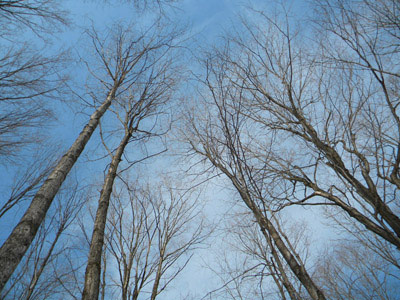
Day 3
I worked up in our Taconic mountain sugarbush today; it faces east. Ask 4 different sugarmakers what they think the ideal sugarbush orientation is and you’ll get 4 different answers. As a basic rule, north is too cold, south is too warm, east is too dry, west is . . . I forget what’s wrong with west. Probably something to do with wind damage and being in the path of all the weather. In any case, the real answer is that it doesn’t much matter. None of us can change which way our trees face, so it is what it is.
We’ve been managing this particular sugarbush for over 30 years, a fact that makes us feel both accomplished and exasperated. There are areas that we’re very proud of, areas where we’re able to see the fruits of our forestry work. Little 8- and 10-inch maples that were released in the 1980s have today come into their own as crop trees. The areas we’re especially proud of are the ones that feature mature, well-spaced, well-plumbed trees that are surrounded by hundreds of maple saplings. We feel like good stewards, then. We can imagine someone tapping this next generation of trees long after we’re gone.
The flip side of the coin is coming to terms with our learning curve and making peace with the things we didn’t do right. My father, who’s the brains behind the forestry work, gets frustrated by the stands that he didn’t thin aggressively enough. (This brings to mind former Bennington County Forester Jim White’s mantra that no sugarmaker should ever thin his own sugarbush because it’s just too hard to kill your darlings.) I get frustrated with the antiquated sections of mainline and tubing infrastructure that today just seem all wrong. In the days before vacuum, long lateral lines were the rule. Now, cutting edge sugarmakers are making a half gallon a tap on lines that average about 2 or 3 taps per lateral. As we aspire for better numbers, there’s a lot of reimagining that has to be done with our older sections of tubing.
Dad and I worked together today and got another 200 holes poked. We’re going so slow because we’re pulling lines up out of thigh-deep snow as we go. We’re changing over from the old style straight spile to the Leader stubby ends as we tap, which also takes time. We’re also running new lateral lines to pick up the easy red maples that are within reach on account of an op/ed we read in Northern Woodlands last spring.
They’re calling for mid 40s today here; we may get our first run.
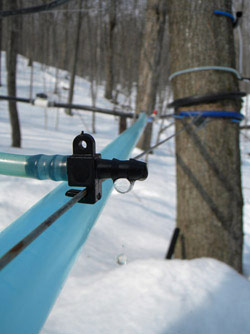
Day 4
It hit 55 yesterday, which is a bit too warm. An ideal sap day might begin with lows in the high twenties, the temperature would then peak out in the low forties, before dropping below freezing again after dark. Too hot and the sap degrades. Later in the season, high temperatures cause the tapholes to degrade as well, as all kinds of different taphole-closing bacteria are emboldened by the sun. (Mike Snyder will tell you all about this in the Spring issue of Northern Woodlands, which should be showing up in your mailbox the end of next week).
Since we’re hopelessly behind on our linework, the high temperatures were welcomed with open arms. Snowshoes only help so much, and we’re all a bit sore from slogging through the too-deep snow. If these temperatures can knock the snowpack back a bit for us, we’ll be very grateful.
The snow probably needs to get knocked back before the trees will run well, too. There’s still a lot of mystery in sap flow. We know the basic framework: It needs to freeze then thaw for it to run. Then the variables come in. High pressure days aren’t great sap days because the greater the pressure difference between the inside of the tree and the outside, the better the run. (Of course sugarmakers with vacuum should be immune to this because their lines are always low pressure . . . “should” is in italics because my experiences haven’t always synced up with what’s in the textbooks.) When it freezes too fast, it won’t run well the next day. Then there are all the vagaries of sugarbush microclimates, which is to say that none of us really know what the temperature is out there on any given day. The temperature of a tree’s bark will be dramatically different this time of year than its core temperature. The temperature at snow-level will be much different than the temperature at branch tips. The trees with south exposure will be . . . you get the idea. You can go nuts trying to explain/predict this stuff. And so we revert to another basic rule that holds that on deep snow years you need a halo of melt around the trunk before the tree starts running well. And because we’re too tired to think about this critically, we’re welcoming 55 degrees and saying: “come on halos.”
My brother came up and worked with us this afternoon. In all we got another 400 holes poked, more spiles changed over, and a really bad section of blow-down-damaged mainline up and operational. It did run but slowly – I didn’t even bother to get the flashlight and look to see how much was in the tank. We limped out of the woods at dark and sat on our tailgates and drank beer and watched the Snow Moon rise. We’re over half way tapped in this particular sugarbush and about a quarter done overall. We toasted our incremental progress and took solace in the fact that it’s supposed to get cold again this weekend.
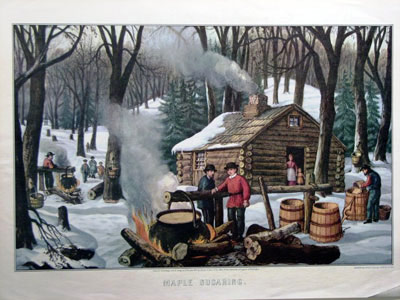
Day 11
If I were blogging for one of those magazines that specialize in bringing rosy-cheeked rural stories to urban locals, these dispatches from the sugarwoods would have to conform to an almost play-like template. I’d be the quaint New England farmer and you, the reader, would get to revel in my Protestant work ethic and my evocations of the pastoral forest and farmstead. The goal for me as the blogger would be to create a pristine world, straight out of the past, into which I’d project my farming endeavors.
Of course, baring the Amish, profit-motivated agriculture’s not like this for anyone anymore. The full timers – whether they work in dairy or maple or any other form of ag – may still wear the beat up grease-stained feed cap but beneath the cap lies a CEO in charge of a multi-million dollar operation. Don’t let the quaint accent fool you.
On the other end of the spectrum are people like me who run significant enough operations while still holding day jobs. One of our “farm” chores involves going to the office and working 8 hours so the bank doesn’t take our house. Many of you sugarmakers out there reading this are in the same boat, and if we include all forms of agriculture, there are tens of thousands of us in the Northeast. Associate Editor Chuck Wooster runs a CSA when he’s not working at the magazine. Our forester friends up the road at Redstart moonlight as loggers, Christmas tree growers, and sheep farmers when they’re not preparing management plans for clients.
There’s a lot of press about the death of farming in the Northeast, and some of the hand-wringing is absolutely valid. Certainly the family farm as we knew it in the 1950s is disappearing and the human and cultural reverberations of this are felt by all rural people. But the overall picture is not as bleak as some make it sound. What it means to be a farmer has changed. The line between blue collar and white collar has been blurred as a new generation of quote unquote parttimers have become the critical mass that keeps agriculture relevant in many parts of the Northeast.
In any case, i spent three days in the office this week, and returned yesterday to the sugarwoods with a vengeance. Dad and new Bennington County forester Chris Stone had tightened lines up in the northernmost section of our farm bush, and I spent the morning tapping that out. We got about 300 more holes poked. The snow where we were working is tattooed with fisher tracks – big male ones, littler female ones. There’s a 300-gallon sap ice cube sitting in the bulk tank that we may work on thawing and use to sweeten the pans tomorrow. Weather’s right on the edge for sap; not sure when we’ll make our first syrup.
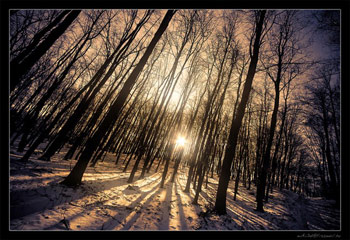
Day 13
Ginny Barlow and Courtney Haynes made the trip south from Corinth today to help tap. They left at around 6 and showed up at around 9 on account of snow-covered roads, a condition that has been ubiquitous all winter. After buying lunch at the Shaftsbury County Store, we traipsed up into the Hall bush, so named for the family that owns it.
The Hall bush sits up on what’s aptly called “Maple Hill.” This is part of the Green Mountain range, as opposed to our farm bush which sits over on the Taconics. The Taconics have a more southern flavor: maples mingle with bitternut hickories and black birches and red oaks. The Hall bush, on the other hand, is your standard maple, beech, birch woods that northern New England is famous for. The site is a classic sugarbush. The maples dominate the forest and are as vigorous as any I’ve ever seen. The woods were thinned 10 or so years ago with the idea of sugaring in mind, and so the trees are relatively well spaced. The pitch is perfect for tubing, and the tubing infrastructure is new and well thought out. I’m most proud of a 30-foot chasm we spanned with 11/4 mainline. My friend K works for the phone company, so we borrowed a lasher and some aggressive cable and spanned the gap like you’d string a telephone line.
The day was perfect despite the cold temperatures and deep snow. It was one of those days where it snowed while the sun was out – the flakes like moths or down feathers swirling in the breeze. We tapped 500 trees then went home to put our sore backs towards the wood stove. Venison stew for dinner. They’re calling for more snow tonight.

Day 15
Worked in light sleet and misty rain on Monday; between Trev, Dad, and I, we got almost 400 more taps put in. The rain wasn’t substantial enough to diminish the snowpack, but it did do a good job of illuminating just how much snow is out there. When it’s cold it’s hard to tell how much snow is in the woods. Snowshoes keep you up on the crust, and the snow lines on the landscape are soft and curvy. When it rains the soft lines become hard. Boulder faces emerge and the snow on top of them stands sharply, giving you some indication of the depth. When you have to take off your snowshoes to use a chainsaw on a downed limb, you sink deeply into the wet mush.
The rain also does a great job at bringing out the colors in the woods. When wet, the lichen and mosses on the maples really pop in their various shades of white and green. The rock wall in the chasm we spanned with our mainline glows with shades of orange and purple that are imperceptible when it’s dry.
We collected 300 gallons of sap from the farm that night – the same sap that had been sitting in the bulk tank since day 4 of this affair. It’s the same olive-green color as some of the lichens on the maple trees on account of 10 months worth of skank in the tubing. Some sugarmakers just let the first sap of the year run onto the ground. Once the tubing has been self-cleaned and the sap is clear, they start collecting. We boil the skank and put the dark, slightly funky-tasting syrup we make from it into a drum and sell it as “commercial grade” syrup to a packing house. They’ll either turn it into maple sugar, or sell it as maple flavoring. Still a third set of sugarmakers (who will be upset with me for saying this) try to turn lemons into lemonade and proudly market the first syrup of the year as First Run Syrup, a slogan that makes other sugarmakers chuckle and wrinkle their nose at the image of swampwater sap.
The first boil of the year is colloquially referred to as “sweetening the pans.” It gives sugarmakers a chance to troubleshoot their equipment, to make sure everything’s up and running right. For instance, as the three of us sat around and sniffed the first steam of the year billowing from our evaporator Monday night, we all wondered why it smelled like candles. The smell got progressively worse. Picture the luscious smell of sap steam, then add an acrid candle-wax smell, like when you overheat paraffin on the stove. 20 minutes in we realized we’d forgotten to take the plastic wrapping off the new section of smokestack pipe we’d installed that winter.
This is why sweetening the pans on an early season, low-stress night is key. The kinks all have to be worked out of the system as this syrup-making machine, 10-months dormant, clanks and rattles and wheezes back to life.
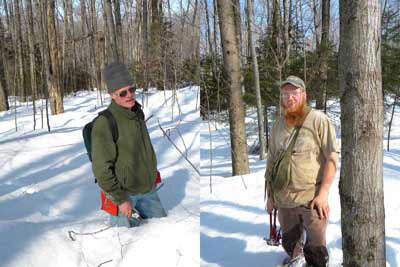
Day 18
After a few days of bread work in the office we’re back at it today. Our friend Jake joined dad and I as we worked in the Hall bush. We got another 150 taps in, but more importantly, we got most of the lines all pulled up out of the snow. The picture of dad here gives some sense of what it’s like to flounder around the woods without snowshoes. The smile on Jake’s face in the other picture gives you some sense of what it’s like to be young and unfazed by snowdepth or a lack of snowshoes (or a coat for that matter – tough hombre, that kid).
As the days in March start to tick by, the snow depth is beginning to worry us. I’ve read some reports in newspapers this year about years of deep snow being good for sugarmakers, and these reports are, in a sugarmaking sense, dead wrong. No sugarmaker likes deep snow. There may be an ecological benefit to a tree from heavy snow, as the snow insulates the roots and provides a slug of spring moisture as it melts, but it delays a sugaring season, and it makes woods work 187 times harder than it would be on open ground.
The idea of a delayed season is at the heart of our worries. Here in southern Vermont, we really don’t make much syrup in April, so March days are precious. Here’s a list of our first boil date, last boil date, and number of boiling nights in a season from the last 11 years:
2000:
2/29 - 3/22 - 15 days
2001:
3/15 - 4/8 - 17 days
2002:
2/22 - 3/31 - 17 days
2003:
3/9 - 4/13 - 12 days
2004:
3/1 - 3/27 - 17 days
2005:
3/14 - 3/31 - 12 days
2006:
2/17 - 3/29 - 13 days
2007:
3/12 - 3/27 - 11 days
2008:
3/5 - 4/7 - 21 days
2009:
3/3 - 4/2 - 19 days
2010:
2/28 - 4/2 - 14 days
You’ll see we average 15 nights of boiling, and that our average end date is April 2. Every March day that ticks by without sap is one less chance we have to put syrup in drums before that deadline. I shudder to think that it could be one of those two week seasons, but that’s sugaring. It’s a tremendous amount of work compressed into a tiny little window and we’re completely at the mercy of the weather gods.

Day 19
46 and rain on Sunday; around midnight last night it turned to ice. I lay awake in bed and listened to the ice-burdened bows of the big silver maple outside my window flopping wearily on the roof. A few retorts as some limbs cracked. When a limb breaks under an ice-load it sounds like a muffled gun shot. It’s a sickening sound. Heading out into the sugarbush to survey the damage now while praying that the heavy snow will stop.
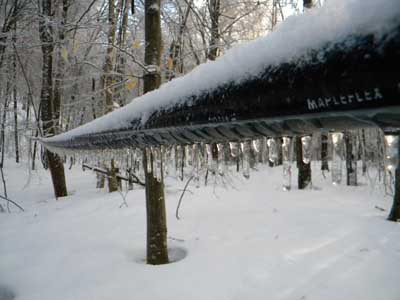
Day 20
So it seems as though we dodged a bullet with the ice. There was some limb damage, and we lost a few trees, but most of our maples seemed burdened and bowed but not broken. The paper birch, poplar, and white pine seemed to take it the worst; some lost their crowns. Every time there’s an ice storm there’s the potential for utter devastation, so we’re all breathing a sigh of relief.
The sap ran for a little while yesterday, but only the trees in direct sun. Dad spent most of the morning fixing vacuum leaks; on an old tubing system, you have to be content with modest gains on this front. By the end of the day our mainlines were pulling 18 inches of vacuum, which is not where we want to be but it’s getting better (at the start of the season we were pulling 10 inches).
Thanks to the other sugarmakers who are adding their own reports to this blog on our facebook page. Mike Ghia in Saxtons River, VT, sweetened the pans on 3/5. The folks at Northwoods Farm and Forestry in Newfane, VT, have boiled about 200 gallons but are still waiting for the first real run.
I’d love to hear how more of you are doing. How about you more southern folks in MA, NY, CT? You making any syrup yet? I’d also be interested to hear how other sugarmakers fared with the ice, or heavy snow, earlier this week.
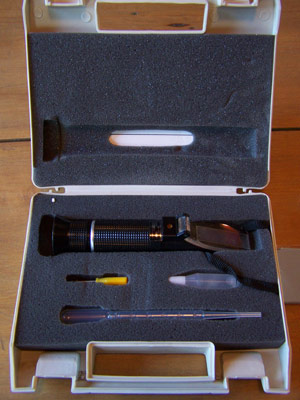
Day 21
Since people are reading this blog in a variety of formats, reader’s comments are not always visible. If you didn’t see it, Pete Antos-Ketcham from Shaker Hill Sugarworks in North Starksboro, VT, checked in yesterday with a report that their first sap of the season was 1.6% sugar. Since the sap’s not running for anyone so well at the moment, and since there’s not much to report on in the woods, I figured it may be worth explaining to non-sugarmakers exactly what sugar content percentages mean.
The sugar content in maple sap is measured on a refractometer. Picture a little hand held telescope. You put a drop of sap on a glass plate, then stare into the telescope and a percentage pops up. To translate the percentage into real world terms, you divide the number into 86. (A fellow named C. H. Jones penned this equation, so it’s colloquially referred to as “Jones’s rule of 86.”)
Thus, it’s going to take about 54 gallons of Pete’s 1.6 percent sap to make a gallon of syrup. Fortunately, the sugar content should get higher as the season progresses. As a tree shakes off its winter dormancy it’s logy and there’s not a lot of metabolic activity going on. At the height of the season, when the tree’s warmed up and is efficiently converting starch to sugar, the sugar content in a mature tree should be up around 2.5 percent. At the end of the season, though, as the tree depletes its starch reserves, the sugar content plummets again.
There’s no predicting the exact percentage at any given time, as a tree’s sugar content not only varies from week to week but also from year to year. Bad growing summers mean depleted starch reserves the following winter, which can translate into lower spring sugar content. In Vermont, one forest pathologist I spoke to indicated that starch reserves are probably somewhat lower than normal this spring on account of the drought conditions we experienced last fall. Areas across the region that experienced defoliation last spring by the late frost, or defoliation by insects last summer, should also have trees with somewhat lower starch reserves.
Also playing a role in a tree’s sugar content are tree health and where the tree grows. If you tap a sprawling yard-maple with a big ol’ regal crown, it’s going to yield dramatically sweeter sap than a woods tree with a small crown. The yard maple doesn’t have to compete with any neighbors for nutrients and light, which means a bigger crown, more leaves, more photosynthesis, more starch, and more sugar.
Finally, and perhaps most interestingly, tree genetics play a role in sugar content. Like brown-eyed children of brown-eyed parents, little maples can inherit sweet or not-so-sweet sugar genes from their parents. Scientists in New England, New York, and Ohio started studying super-sweet maples in the 1950s. They identified sweet trees and cloned them. Today, the progeny of these super sweet trees average six-to-seven percent sugar in a season, with some incidences of 10 or even 12 percent reported.
We haven’t tested our sap yet, but I will today. It’s around 39 degrees as I write this on Thursday morning and we have about 1,000 gallons of sap from yesterday waiting to be boiled. I’m going to head out, turn on the vacuum pump, and hope for more today.
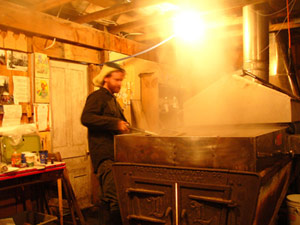
Day 26
So we collected about 3,100 gallons of sap on Thursday and Friday. The nights didn’t get quite cold enough on Friday and Saturday to be conducive to a big run, but the Hall bush, being naturally colder, ran a bit for us. All told we boiled about 4,200 gallons of sap.
We’re still boiling on a 3.5 x 10’ Leader Special (I think that’s what it was called), which won’t mean anything to you non-sugarmakers but will make other sugarmakers spit coffee out their noses. This is a 1980s-era evaporator that’s rated for about 800 taps. With our tap count, one might analogize this to running a NASCAR race in a Kia. We’re able to do it because we use an RO to concentrate the sap before we boil it, the equivalent of putting a jet engine in said Kia.
RO stands for Reverse Osmosis. Picture a high-tech looking rectangle, about the size of a small closet, which runs on electricity. It’s basically a high-pressure pump hooked up to an enormous filter. The filter is, more accurately, a semi-permeable membrane that will allow water molecules to pass through but not sugar molecules. Sap is about 98 percent water. When it gets blasted through the membrane, clean, diluted water comes out the other side, and the remaining sap is correspondingly sweeter. (It should be noted that this is my slap-dash, layman’s understanding of how an RO works. Kids, do not write your school papers based on this information – make some phone calls to people who actually understand what’s happening. Physicists, please bolster/correct my science here if warranted). What I am sure of is we’re taking about ¾ of the water out of the sap before we boil it, so 1000 gallons of 2 percent sap becomes 250 gallons of 10 percent concentrate before it even hits the pan. Our machine concentrates 1,200 gallons of sap an hour.
Had a lot of guests this weekend, including my dad’s brothers Tom and Dan and Tom’s son Eric, who fed the fire all day Saturday. Several fellow sugarmakers swung by to visit and there’s great excitement that this is going to be a good sap week. At least on the television screen, the weather looks to be lining up nicely. As the Gardeners left last night, Mike said: “Let’s hope we’re exhausted by Thursday.”
Here’s hoping.
Syrup to date: 75 gallons
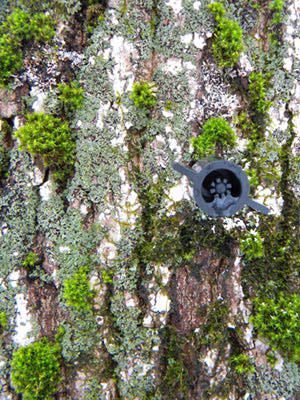
Day 29
A good hard freeze on Monday night led to a good run yesterday. It took a little while to get going, but once it did, it ran. I don’t know if it froze here last night or not, which will determine if today’s a good run or not. Off to work in the rain.
Syrup to date: 96 gallons
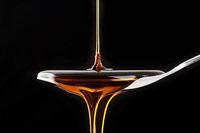
Day 30
It ran through the night Tuesday night and we boiled through the night last night. Trickled yesterday, but we need a good freeze to bring it back. It hit 32 degrees last night, which is not quite cold enough. This is the razor’s edge between strong run and weak run. Still, we’re making beautiful syrup. Color wise it’s straddling the line between medium and dark and taste wise it’s as good as anything we’ve ever produced.
Syrup to date: 141 gallons
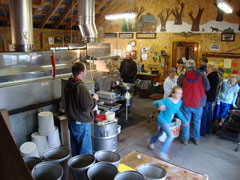
Day 32
The warm temperatures continue to worry us, though yesterday’s sun was a guilty pleasure. In T-shirts, we boiled 900 gallons of sap and made medium amber syrup. Austin Buttle came by and worked with us for a few hours in the afternoon – Austin’s a fifth grader at Shaftsbury Elementary School. He cheerfully hopped into our grimy bulk tanks, armed with a mop pail and a sponge, and when he reemerged they were spotlessly clean. It was a great help. I boiled what was left of the sap – about 900 gallons – then chased the pans with RO water to clean the niter scale off the bottom.
We’re expecting visitors this weekend for Open House weekend, an event that gets bigger and bigger every year. Used to be we’d have an occasional visitor show up to the sugarhouse; now, we get hundreds of people a day from all over the country. The public relations arm behind this event has done a wonderful job of getting the word out.
For more information about maple open house events in your state, visit the following links:
NY: http://www.mapleweekend.com/
VT: http://www.vermontmaple.org/open-house-weekend.php
NH: http://www.nhmapleproducers.com/weekend2011.html
ME: http://www.mainemapleproducers.com
MA: http://www.massmaple.org
CT: http://www.ctmaple.org
RI: http://www.farmfresh.org/food/food.php?zip=02909&food=69
Syrup to date: 185 gallons
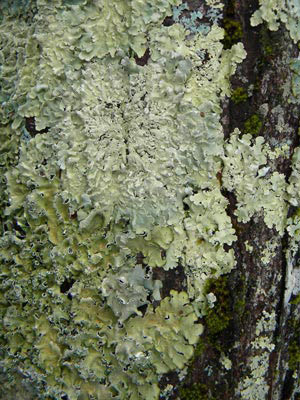
Day 37
Had a very busy Maple weekend, where we entertained visitors from all over the northeast. The sugarhouse was manic enough that we boiled unconcentrated sap – enough to give the place a good smell but not enough to require our full attention. Had we boiled in earnest we would have burned the pans up for sure. It was really nice having the guests and seeing their enthusiasm. We made a lot of new friends and some new customers, too.
The too-hot weather from the end of last week blew out Saturday and good sap weather returned. Cranked up and boiled hard Sunday night and Monday.
Made 30 gallons of nice dark amber yesterday, which puts us at about half a crop. The weatherman says unseasonably cold weather for the next two weeks, which could be perfect. By this point in the season the trees are looking for any excuse to run, so 36 or 38 degrees and cloudy is often great sap weather. Time will tell.
Syrup to date: 289 gallons
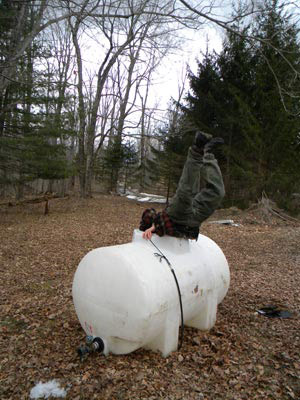
Day 39
There comes a time in every maple sugaring season when I feel compelled to share a bit of hard earned advice with my fellow sugarmakers. Paying heed could mean the difference between a successful final few weeks of the season and utter disaster.
So you know those industry standard 325-gallon plastic gathering tanks? Now there are two kinds – the kind with a little hole in the top that makes cleaning the thing impossible, and the kind with the larger hole in the top that makes cleaning a breeze. Kind of.
Now as you’re cleaning this tank with the just-about-large-enough-to-fit-in hole, you may notice a stray leaf or twig just below the opening. As the foreign object will be, inevitably, just out of reach, you’ll have to cram your torso inside the tank after it - and herein lies the catch.
If you’re a man of average build, fitting into the hole is snug but possible. But since many of us clean our tanks in the cold morning weather of peak sugaring season, our frames will be made bulkier by heavy clothes and bulky coats. As you slide head-first into the tank to the point where the waist of your inverted body is even with the opening, you may find, after you’ve removed the stray leaf, that you are, in fact, trapped. Your bulky coat will make egress impossible, and you’ll look, to all the world passing by, like a large human wine cork with two wiggling legs. And being a New Englander who appreciates quality textiles, that coat’s not gonna rip.
Claustrophobia will quickly set in, and you’ll find yourself, after a frantic bout of struggle, wondering if this could really be it. You won’t feel panic as much as intense shame, picturing an embarrassing photo of your limp behind in the paper under some snarky headline: Local Editor Proves Darwin Right! And you’ll regret that time you laughed cruelly at your poor beagle who’d gotten his head stuck in a sap bucket and was running around panicked (an act that prompted snide comments about a family tree with few branches).
Your problems will be compounded if visitors are dropping by the sugarhouse at just that moment. You see, people are unaccustomed to such sights and there’s no telling how they’ll act. In a best case scenario, when presented with wiggling buttocks wedged in a sap tank, a passer-by may simply grow uncomfortable and leave. But if you’re unlucky, said passers-by could be mischievous youngsters who might use your disadvantage to exact acts of cruelty that would, no doubt, go down in the annals of legendary local hijinks (the stinging thwoop of a paintball comes to mind). Worse yet, these teenagers could be your kids!
Beyond physical harm, there’s an inherent P.C. component to such mishaps that cannot be overlooked. One must always be aware that the sight of a man’s bottom wiggling suggestively can be perceived as downright offensive in our increasingly proper society; and as a sugarmaker, you must always be conscious that you are a symbol of all that is pure and folksy in this region. People expect this. You can imagine, then, the shock of the offended when a visitor stops by for some delicious fresh syrup and instead get strange noises and an unmistakably full moon (full, since by now the weight of your wet pant cuffs, coupled with the exertion of trying to free yourself, and the 10 pounds you’ve lost from collecting buckets for three weeks will have rendered your buttocks fully exposed). You’ll just be able to make out the offended “I never” through the tank’s polyprophelene walls before being left alone to dwell on lost sales, terrible P.R., and the irony that your “mooning” managed to simultaneously cover both the true definition of the word as defined in the Oxford English Dictionary (“to pass time in a listless manner”) and the slang meaning!
Now eventually you’ll come to realize that the way out of your predicament is to crawl all the way inside the tank, where you’ll be able to turn around, and, with embarrassing ease, crawl out the way you came.
Free at last, you’ll look around to see if anyone witnessed your mental flatulence. Then you’ll head inside to dry your clothes and give the beagle some extra food. Afterwards, you may find yourself at a south-facing window, picking up the spring’s first buzzing flies, guiding them away from the window glass, towards freedom.
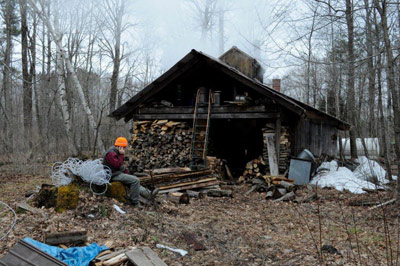
Day 53
So our sugaring season is coming to a close. As I write this we’re at 576 gallons. It froze hard last night and should run well today, so our goal of 600 gallons is certainly within reach. It’s been a successful season on the numbers front. More importantly, though, it’s been a disaster-free season; as our friend and fellow sugarmaker John Williamson points out, this is the most important thing. There were no injuries or accidents. No major equipment malfunctions. Last night Dad, Trev, and I sat around the rig with hang-dog tired faces but we were still smiling and cracking jokes.
The sugarhouse looks as tired as we do. It’s devolved into mess – empty pizza boxes have begun to pile on the tables, wood chips, bark, and ash coat the floor in front of the evaporator. In the beginning of the season we diligently clean before every boil, but late in the year it’s hard to summon the extra energy. The boards in the sugarhouse are so impregnated with steam that it smells like you’re boiling even when you’re not. Along the north wall, stainless steel barrels full of syrup are stacked two high. They bulge out in such a way that you have to slink by them – a good problem to have.
I’ll write one more blog to give you a final season tally when that number comes, but otherwise this will be it. Time to get on with life, with spring. The peepers are calling down here in southern Vermont and our energies are drifting into other things. Thanks for reading and following along.
Day 55
We hit 626 and drank champaign. Then we said: “done.” On with life.
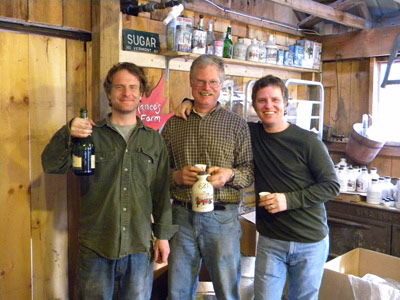


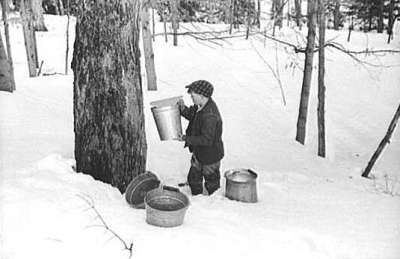
Discussion *